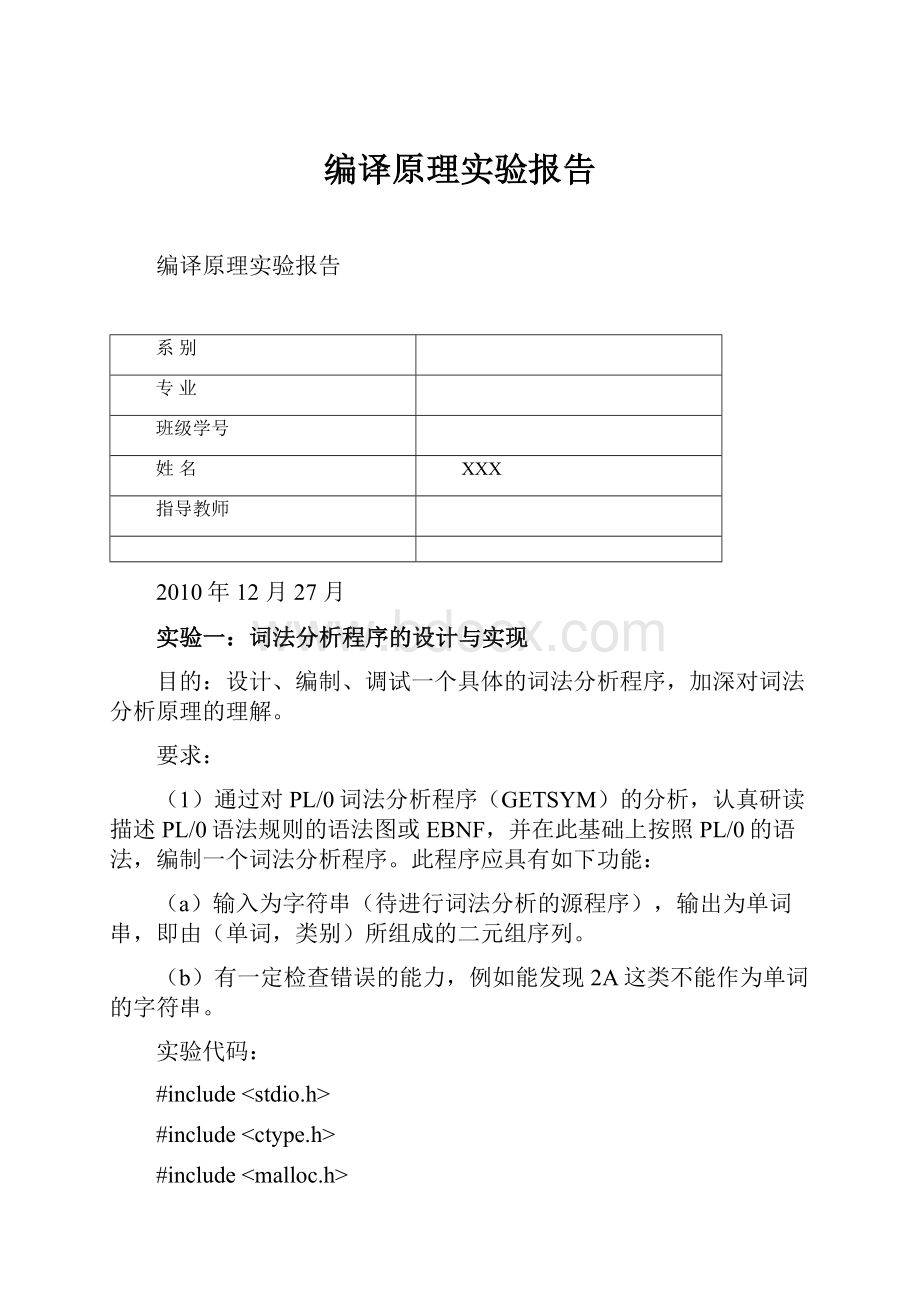编译原理实验报告.docx
《编译原理实验报告.docx》由会员分享,可在线阅读,更多相关《编译原理实验报告.docx(19页珍藏版)》请在冰豆网上搜索。

编译原理实验报告
编译原理实验报告
系别
专业
班级学号
姓名
XXX
指导教师
2010年12月27月
实验一:
词法分析程序的设计与实现
目的:
设计、编制、调试一个具体的词法分析程序,加深对词法分析原理的理解。
要求:
(1)通过对PL/0词法分析程序(GETSYM)的分析,认真研读描述PL/0语法规则的语法图或EBNF,并在此基础上按照PL/0的语法,编制一个词法分析程序。
此程序应具有如下功能:
(a)输入为字符串(待进行词法分析的源程序),输出为单词串,即由(单词,类别)所组成的二元组序列。
(b)有一定检查错误的能力,例如能发现2A这类不能作为单词的字符串。
实验代码:
#include
#include
#include
#include
#include
#defineNULL0
FILE*fp;
charcbuffer;
char*key[8]={"if","else","for","while","do","return","break","continue"};
char*border[6]={",",";","{","}","(",")"};
char*arithmetic[4]={"+","-","*","/"};
char*relation[6]={"<","<=","=",">",">=","<>"};
char*consts[20];
char*label[20];
intconstnum=0,labelnum=0;
intsearch(charsearchchar[],intwordtype)
{
inti=0;
switch(wordtype)
{
case1:
for(i=0;i<=7;i++)
{
if(strcmp(key[i],searchchar)==0)
return(i+1);
}
case2:
{for(i=0;i<=5;i++)
{
if(strcmp(border[i],searchchar)==0)
return(i+1);
}
return(0);
}
case3:
{for(i=0;i<=3;i++)
{
if(strcmp(arithmetic[i],searchchar)==0)
{
return(i+1);
}
}
return(0);
}
case4:
{for(i=0;i<=5;i++)
{
if(strcmp(relation[i],searchchar)==0)
{
return(i+1);
}
}
return(0);
}
case5:
{for(i=0;i<=constnum;i++)
{
if(strcmp(consts[i],searchchar)==0)
{
return(i+1);
}
}
consts[i-1]=(char*)malloc(sizeof(searchchar));
strcpy(consts[i-1],searchchar);
constnum++;
return(i);
}
case6:
{for(i=0;i<=labelnum;i++)
{
if(strcmp(label[i],searchchar)==0)
{
return(i+1);
}
}
label[i-1]=(char*)malloc(sizeof(searchchar));
strcpy(label[i-1],searchchar);
labelnum++;
return(i);
}
}
}
charalphaprocess(charbuffer)
{
intatype;
inti=-1;
charalphatp[20];
while((isalpha(buffer))||(isdigit(buffer)))
{
alphatp[++i]=buffer;
buffer=fgetc(fp);
}
alphatp[i+1]='\0';
if(atype=search(alphatp,1))
printf("%s(1,%d)\n",alphatp,atype-1);
else
{
atype=search(alphatp,6);
printf("%s(6,%d)\n",alphatp,atype-1);
}
return(buffer);
}
chardigitprocess(charbuffer)
{
inti=-1;
chardigittp[20];
intdtype;
while((isdigit(buffer)))
{
digittp[++i]=buffer;
buffer=fgetc(fp);
}
digittp[i+1]='\0';
dtype=search(digittp,5);
printf("%s(5,%d)\n",digittp,dtype-1);
return(buffer);
}
charotherprocess(charbuffer)
{
inti=-1;
charothertp[20];
intotype,otypetp;
othertp[0]=buffer;
othertp[1]='\0';
if(otype=search(othertp,3))
{
printf("%s(3,%d)\n",othertp,otype-1);
buffer=fgetc(fp);
gotoout;
}
if(otype=search(othertp,4))
{
buffer=fgetc(fp);
othertp[1]=buffer;
othertp[2]='\0';
if(otypetp=search(othertp,4))
{
printf("%s(4,%d)\n",othertp,otypetp-1);
gotoout;
}
else
othertp[1]='\0';
printf("%s(4,%d)\n",othertp,otype-1);
gotoout;
}
if(buffer==':
')
{
buffer=fgetc(fp);
if(buffer=='=')
printf(":
=(2,2)\n");
buffer=fgetc(fp);
gotoout;
}
else
{
if(otype=search(othertp,2))
{
printf("%s(2,%d)\n",othertp,otype-1);
buffer=fgetc(fp);
gotoout;
}
}
if((buffer!
='\n')&&(buffer!
=''))
printf("%cerror,notaword\n",buffer);
buffer=fgetc(fp);
out:
return(buffer);
}
voidmain()
{
inti;
for(i=0;i<=20;i++)
{
label[i]=NULL;
consts[i]=NULL;
}
if((fp=fopen("example.c","r"))==NULL)
printf("error\n");
else
{
cbuffer=fgetc(fp);
while(cbuffer!
=EOF)
{
if(isalpha(cbuffer))
cbuffer=alphaprocess(cbuffer);
elseif(isdigit(cbuffer))
cbuffer=digitprocess(cbuffer);
elsecbuffer=otherprocess(cbuffer);
}
printf("over\n");
getchar();
}
}
截图如下:
实验二:
递归子程序法语法分析程序的设计与实现
目的:
设计、编制、调试一个典型的语法分析程序,实现对如下文法的递归子程序语法分析,进一步掌握常用的语法分析方法。
要求:
程序的输入是任意符号串,输出是本次输入的符号串是否是该文法的句子的结论。
实验代码:
#include
#include
#include
#include
chara[50],b[50],d[200],e[10];
charch;
intn1,i1=0,flag=1,n=5;
intE();
intE1();
intT();
intG();
intS();
intF();
voidinput();
voidinput1();
voidoutput();
voidmain()
{
intf,p,j=0;
charx;
d[0]='E';
d[1]='=';
d[2]='>';
d[3]='T';
d[4]='G';
d[5]='#';
printf("请输入字符串(长度〈50,以#号结束)\n");
do{
scanf("%c",&ch);
a[j]=ch;
j++;
}while(ch!
='#');
n1=j;
ch=b[0]=a[0];
printf("文法\t分析串\t\t分析字符\t剩余串\n");
f=E1();
if(f==0)return;
if(ch=='#')
{
printf("accept\n");
p=0;
x=d[p];
while(x!
='#'){
printf("%c",x);
p=p+1;
x=d[p];/*输出推导式*/
}
}
else{
printf("error\n");
printf("回车返回\n");
getchar();getchar();
return;
}
printf("\n");
printf("回车返回\n");
getchar();
getchar();
}
intE1()
{
intf,t;
printf("E→TG\t");
flag=1;
input();
input1();
f=T();
if(f==0)return(0);
t=G();
if(t==0)return(0);
elsereturn
(1);
}
intE()
{
intf,t;
printf("E→TG\t");
e[0]='E';
e[1]='=';
e[2]='>';
e[3]='T';
e[4]='G';
e[5]='#';
output();
flag=1;
input();
input1();
f=T();
if(f==0)return(0);
t=G();
if(t==0)return(0);
elsereturn
(1);
}
intT()
{
intf,t;
printf("T→FS\t");
e[0]='T';
e[1]='=';
e[2]='>';
e[3]='F';
e[4]='S';
e[5]='#';
output();
flag=1;
input();
input1();
f=F();
if(f==0)return(0);
t=S();
if(t==0)return(0);
elsereturn
(1);
}
intG()
{
intf;
if(ch=='+'){
b[i1]=ch;
printf("G→+TG\t");
e[0]='G';
e[1]='=';
e[2]='>';
e[3]='+';
e[4]='T';
e[5]='G';
e[6]='#';
output();
flag=0;
input();
input1();
ch=a[++i1];
f=T();
if(f==0)return(0);
G();
return
(1);
}
printf("G→^\t");
e[0]='G';
e[1]='=';
e[2]='>';
e[3]='^';
e[4]='#';
output();
flag=1;
input();
input1();
return
(1);
}
intS()
{
intf,t;
if(ch=='*'){
b[i1]=ch;
printf("S→*FS\t");
e[0]='S';e[1]='=';e[2]='>';e[3]='*';e[4]='F';e[5]='S';e[6]='#';
output();
flag=0;
input();input1();
ch=a[++i1];
f=F();
if(f==0)
return(0);
t=S();
if(t==0)
return(0);
else
return
(1);
}
printf("S→^\t");
e[0]='S';e[1]='=';e[2]='>';e[3]='^';e[4]='#';
output();
flag=1;
a[i1]=ch;
input();input1();
return
(1);
}
intF()
{
intf;
if(ch=='('){
b[i1]=ch;
printf("F→(E)\t");
e[0]='F';e[1]='=';e[2]='>';e[3]='(';e[4]='E';e[5]=')';e[6]='#';
output();
flag=0;
input();input1();
ch=a[++i1];
f=E();
if(f==0)
return(0);
if(ch==')')
{b[i1]=ch;
printf("F→(E)\t");
flag=0;
input();input1();
ch=a[++i1];
}
else{
printf("error\n");
return(0);
}
}
elseif(ch=='i')
{b[i1]=ch;
printf("F→i\t");
e[0]='F';e[1]='=';e[2]='>';e[3]='i';e[4]='#';
output();
flag=0;
input();input1();
ch=a[++i1];
}
else{
printf("error\n");
return(0);
}
return
(1);
}
voidinput()
{
intj=0;
for(;j<=i1-flag;j++)
printf("%c",b[j]);
printf("\t\t");
printf("%c\t\t",ch);
}
voidinput1(){
intj;
for(j=i1+1-flag;jprintf("%c",a[j]);
printf("\n");
}
voidoutput(){
intm,k,j,q;
inti=0;m=0;k=0;q=0;
i=n;
d[n]='=';d[n+1]='>';d[n+2]='#';n=n+2;i=n;
i=i-2;
while(d[i]!
='>'&&i!
=0)i=i-1;
i=i+1;
while(d[i]!
=e[0])i=i+1;
q=i;
m=q;
k=q;
while(d[m]!
='>')
m=m-1;
m=m+1;
while(m!
=q){
d[n]=d[m];m=m+1;n=n+1;
}
d[n]='#';
for(j=3;e[j]!
='#';j++){
d[n]=e[j];
n=n+1;
}
k=k+1;
while(d[k]!
='='){
d[n]=d[k];
n=n+1;
k=k+1;
}
d[n]='#';
}
实验截图: